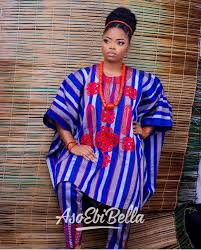Introduction
In the vibrant tapestry of Nigerian culture, few fabrics carry the weight of history and artistry like Aso Oke. This traditional handwoven cloth is a symbol of heritage, deeply rooted in the Yoruba people’s customs. Among its many styles, the Agbada—a flowing robe traditionally worn by men—has been beautifully reimagined for women, marrying tradition with modern aesthetics. In this post, we’ll delve into the rich heritage of Aso Oke, explore the stunning designs of women’s Agbada, and provide guidance on styling, occasions, and care.
1. The Cultural Significance of Aso Oke
Beyond its aesthetic appeal, Aso Oke holds profound cultural significance in Nigerian society. It is often seen as a symbol of wealth, status, and tradition. The fabric’s intricate patterns and vibrant colors often represent specific
cultural symbols and stories, passed down through generations.

2. The Evolution of the Agbada
The Agbada, traditionally a flowing robe worn by men, has undergone a significant transformation in recent years. Women have embraced this style, adapting it to suit their feminine silhouettes. The modern Agbada for ladies often features a fitted bodice with a flowing skirt or pants, allowing for a balance of tradition and contemporary aesthetics.
3. When to Wear Aso Oke Agbada
The beauty of Aso Oke Agbada lies in its versatility, making it appropriate for numerous occasions:
- Weddings: Whether as a bride, bridesmaid, or guest, Agbada adds elegance and flair. Traditional ceremonies often feature women in matching Agbada, showcasing a sense of unity and cultural pride.
- Cultural Events: Festivals such as the Osun-Osogbo Festival or Eyo Festival provide an excellent backdrop to wear Aso Oke Agbada, as participants often don traditional attire to honor their heritage.
- Religious Occasions: Wearing Agbada to church or other religious gatherings is a way to celebrate faith and culture simultaneously, with many women opting for embellished designs that reflect their personal style.
- Social Gatherings: From birthday parties to milestone celebrations, Aso Oke Agbada serves as a stylish choice that captures attention while paying homage to cultural roots.
4. How to style your agbada
To truly shine in your Aso Oke Agbada, consider the following styling tips that enhance your look while respecting cultural significance:
- Fabric Selection: Choose colors and patterns that flatter your skin tone and resonate with your personality. Rich jewel tones like emerald green or deep burgundy can create a striking look, while pastel shades can offer a softer, more romantic vibe.
- Accessorizing:
- Jewelry: Select statement pieces—be it a bold necklace, intricate earrings, or stacked bracelets—that complement your Agbada without overwhelming it. Traditional beadwork can also enhance the cultural aspect of your outfit.
- Footwear: Elegant heels or embellished sandals can elevate your look, providing comfort while ensuring you stand out.
- Bags: A chic clutch or a handcrafted bag made from local materials can add a personal touch. Look for bags that incorporate traditional designs or patterns.
- Hair and Makeup Tips: Hairstyles such as updos, braids, or adorned headwraps can beautifully frame your face and complement the neckline of your Agbada. Opt for makeup that enhances your features; bold lip colors can make a statement while keeping the overall look balanced.

5. Inspiring Looks: Real-Life Examples
Across social media platforms, fashion icons and everyday women alike showcase their interpretations of Aso Oke Agbada, proving its versatility and charm. Influencers such as Tiwa Savage and Toke Makinwa often flaunt stunning Agbada designs, setting trends and inspiring their followers to embrace traditional attire in modern contexts.
6. The Future of Aso Oke Agbada
As fashion continues to evolve, we can expect to see even more innovative interpretations of Aso Oke Agbada. Designers are likely to experiment with new fabrics, patterns, and silhouettes, while still honoring the garment’s cultural heritage.
7. Care and Maintenance of Aso Oke Fabrics
Proper care is essential to preserve the beauty and integrity of Aso Oke fabrics:
- Washing Instructions: Always hand wash your Aso Oke in cold water with mild detergent. Avoid bleach and harsh chemicals, as they can damage the fabric’s fibers and colors. If machine washing is unavoidable, use a gentle cycle with a laundry bag.
- Storage Tips: Store your garments in a cool, dry place, ideally hanging to avoid creasing. If folding, use acid-free tissue paper between layers to prevent any permanent creases.
- Repair Advice: For minor frays or loose threads, a simple needle and thread can work wonders. If you encounter significant damage, consult a professional tailor who specializes in traditional garments to ensure it is repaired correctly.
Aso Oke Agbada is more than just a garment; it embodies a celebration of culture, heritage, and individual style. By embracing this beautiful attire, women can honor their roots while making bold fashion statements. We invite you to share your thoughts, experiences, or photos of your Aso Oke Agbada in the comments below. Together, let’s celebrate the richness of this fabric and the stories it tells!